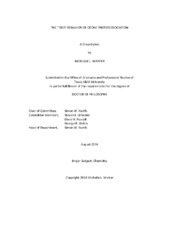| dc.description.abstract | The dissociation dynamics of ozone photolysis in the Hartley band have been studied to help uncover the origin of the rotational population alternation. Velocity map ion imaging experiments have been performed on the dissociation of ozone at 248, 266 and 282 nm. Rotational distributions and vector correlations for the O2 (a ^1Δg) fragment have been measured to elucidate the origin of the observed even/odd J state population alternation. The population alternation is considerably stronger for jet-cooled ozone than the previous measurements at 300 K. The alternation is dependent on J state, i.e., it is weaker at the high and low sides of the rotational distribution, but the alternation is not greatly dependent on photolysis wavelength or O2 vibrational state. A simple curve crossing model has been used to explain the alternation. The difference in temperature between the previous and current experiments has led to the study of the parent internal energy effects on the alternation. The even/odd alternation is clearly present for a 60 ±10 K beam, but is not observed when the beam temperature reaches 200 ±20 K. This is direct evidence that the parent internal energy must be taken into account to explain the origin of the alternation and is inconsistent with a simple curve crossing model.
The dissociation dynamics have also been studied to help determine if the odd and even J states arise from different dissociation pathways. The correlation between fragment velocity and rotational angular momentum, the v-J correlation, has been obtained, and no difference in the v-J correlation is observed between the even and odd J states. A previous research group has reported differences between the even and odd states for a 140 K beam, and the difference was shown to be dependent on fragment speed. Since no alternation is present for the 60 K beam, this indicates that the alternation of the v-J correlation may also be dependent on parent internal energy. The spatial anisotropy, the μ-v correlation, showed no alternation in both the current and previous results. It has been shown that the odd J state population increases with increasing parent internal energy, so the odd states may preferentially arise from parent molecules with out-of-plane rotational motion. When the internal energy of ozone is increased, the out-of-plane motion becomes more significant and produces more odd states. A consequence of this is that the out-of-plane motion will depolarize the v-J correlation more than the in-plane parent rotation, but it will not affect the μ-v correlation. Therefore, it would be expected that if the odd states are associated with rotationally excited parent molecules, the v-J would be more depolarized compared to the even states, but the spatial anisotropy would be the same for both states. | en |


